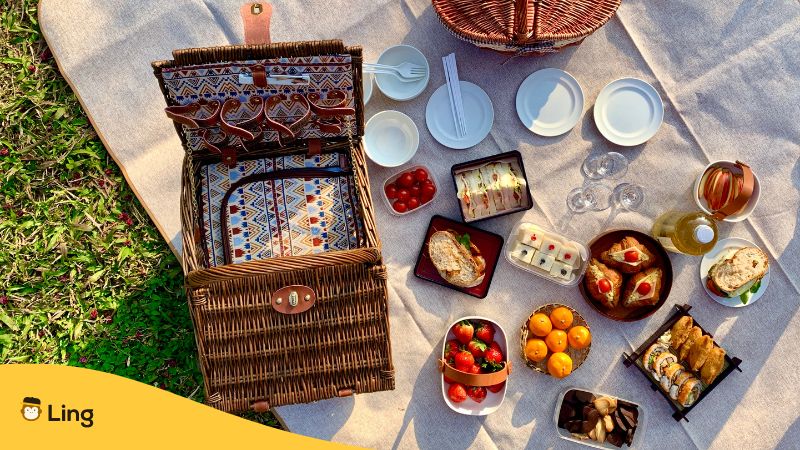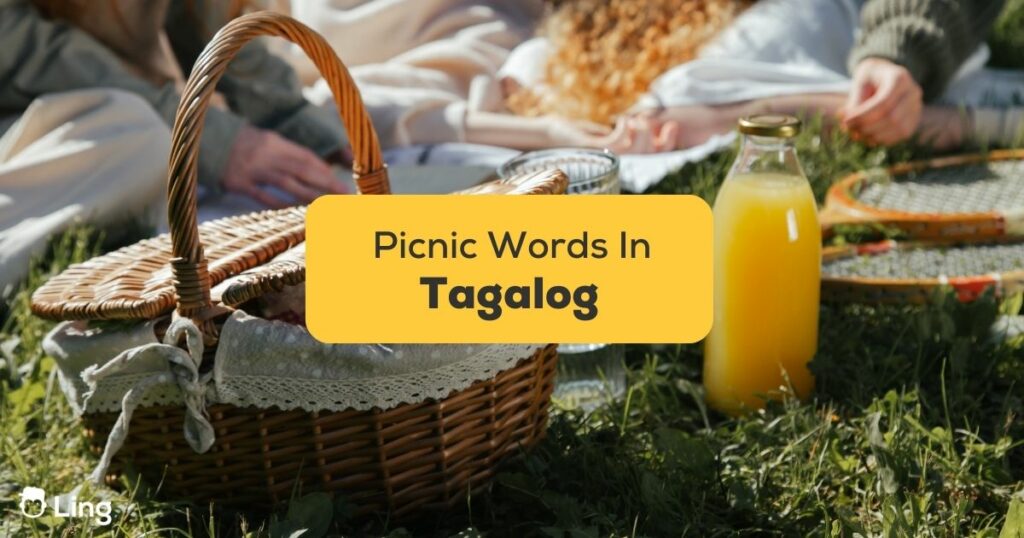It’s time to put our adventure caps on, smear some sunblock, and embark on a linguistic voyage into the heart of Tagalog words for picnic day! Unwind the strings of your hammock, crack open your baunan (lunch box), and let’s begin!
Tagalog, the foundation of the national language of the Philippines—Filipino, is a treasure trove of expressions that sing the tune of cultural richness and communal values. And what better setting to explore this linguistic harmony than the quintessential Filipino picnic—a festive slice of life where food, family, fun, and above all, a fanciful play of words are as spicy as the adobo and as sweet as the summer mangga (mango).
So imagine you’re nestled beneath a sprawling narra tree, a spread of delicious pagkain (food) before you, surrounded by friends, family, and the endless azure sky. Before you dive into the feast, whet your knowledge palate by learning the ‘Tagalog words for picnic’! Think of this as your personal language picnic basket – it’s compartmentalized, filled with delightful bites of learning, and yes, ant-proof!

What Is Picnic In Tagalog?
Who doesn’t love a good picnic? But how do you say “picnic” in the tongue-tingling, melody-rich language called Tagalog? Well, hold onto your salakot (traditional Filipino hat) because the answer is as simple as a cool, sunlit afternoon in the park.
The direct translation for “picnic” in Tagalog is…drumroll, please…”piknik”! 🎉 If you were eagerly anticipating a tongue-twister, sorry to burst your bubble. But that’s just the first layer! Dig a little deeper and you’ll find other words that capture the essence of “picnic” in the Philippine setting. For example, “Kasiyahan sa labas,” which translates to “joy outside,” paints a picture of family, laughter, and the great Philippine outdoors. “Salu-salo,” literally ‘get-together,’ also conveys the convivial atmosphere that is a hallmark of Filipino social gatherings, including picnics.
Now, isn’t that a linguistic fiesta? While piknik is the exact translation, other versions also echo the heartwarming and community-based spirit of picnics in the Philippines – a joyous, shared affordance under the sun or beneath the stars, with food and companionship that gladden the heart.

Common Tagalog Words For Picnic
Let’s unwrap this linguistic banana leaf and see what delectable Tagalog words come spilling out. Each of these words brings a unique flavor to the rich feast that is a Filipino picnic. Are you ready? Let’s go on a virtual picnic and learn!
Pagkain
In a Filipino picnic, or any gathering for that matter, Pagkain (food) is the heart of the matter. And we’re not just talking about any food here. Expect a bounty of mouthwatering dishes and snacks that highlight the diverse culinary traditions of the Philippines. From skewered meats to sticky rice cakes and tropical fruits galore, Filipino picnics are as much a food festival as they are a day out in the sun.
Planning for a picnic with a Filipino? Here are some of the common food items for the picnic:
- Inihaw na liempo (Grilled pork belly) with papaya atchara
- Inihaw na bangus (Grilled Milkfish)
- Pork adobo with rice (Filipino stewed pork belly)
- Inihaw na bangus (Grilled fish stuffed with veggies and spices)
- Pandesal (Filipino bread)
- Filipino Spaghetti
Payong
Meeting a sudden shower during your picnic outing? Don’t fret. Just make sure to always carry a Payong (umbrella) along. This trusty tool can double as a sunshade on hot sunny days and as a shield against unexpected rain. It’s portable, handy, and an integral part of a Filipino picnic experience.
Punongkahoy
Your best friend during a Filipino picnic could be a Punongkahoy (tree). You might find yourself sprawling underneath its shade, enjoying your pagkain, and basking in the calming sounds of leaves rustling in the wind. A Filipino picnic experience is incomplete without gaining a new appreciation for these majestic natural umbrellas.
Ilog
The Ilog (river) is a favorite spot for picnics by Filipinos. The harmonic splash of water, refreshing breezes, and lush landscape it offers make for a paradisiacal picnic setup. Did someone say riverside BBQ? Pass the sinugba (grilled) dishes!
Kasiyahan
Now, this is a fascinating one! Kasiyahan translates to joy or pleasure. But why’s this relevant to picnics, you may ask? Well, in the context of Filipino culture, gatherings of any sort, including picnics, are run-throughs of joy, laughter, companionship, and overall kasiyahan. As you pack your picnic basket, remember you’re also packing a day full of happiness and memories!
Baunan
Baunan (lunch box) is a beloved picnic necessity, carrying a delicious array of homemade pagkain (food) and snacks that set the stage for communal bonding over shared meals. Be it a simple Tupperware or an intricately woven bayong (traditional Filipino market bag), anything can serve as a baunan in the Philippines!
Bangko
Imagine the universal picnic scene – people sitting in the park, legs folded under them or dangling from a bench. That’s where Bangko comes into play. It denotes ‘bench’ in Tagalog. The humble bangko, under ancient trees or by the vibrant riverside. Additionally, it often becomes the impromptu hapag-kainan (eating table) for picnic-goers.
Inumin
Whew! After all this talk about food, benches, and sunglasses, you might be feeling parched. That’s where Inumin comes in! It refers to ‘drinks’ in Tagalog. Be it a thirst-quenching sip of tubig (water) or a cooling sago’t gulaman (sweet beverage), never underestimate the importance of on-hand inumin at a picnic.
Looking to prepare a picnic basket? Here’s a list of the common beverages you may bring along with you:
- Buko juice (Coconut juice)
- Calamansi juice
- Melon juice
Learn The Tagalog Language With Ling
Arm yourself with a pen, a language map, and then dare to discover a whole new world of words with Ling at your side.
You ask, “Why Ling?”
Here’s the straight-off-the-bat answer—Ling takes complex language structures and turns them into bite-sized fun exercises, livening up the whole learning process. Our method treads beyond just education; it’s designed to be entertaining! A mix of multimedia materials, quizzes, and lots of interactive sessions will keep you engaged while you learn. It’s all the fun of board game night, but you pick up a new language skill. Speak about a win-win!
Give it a go today by downloading it from the App Store or Play Store today!



































































